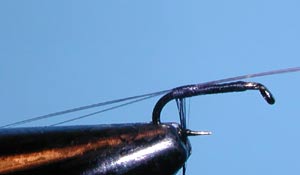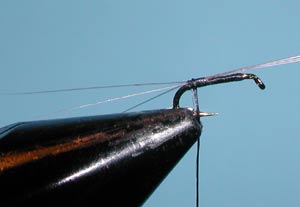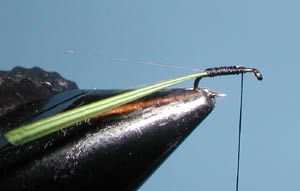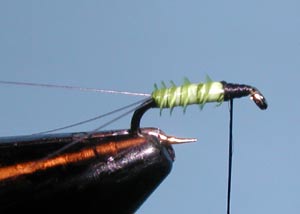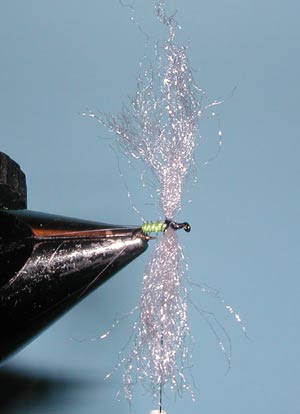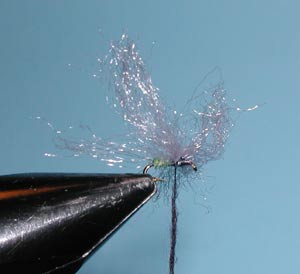Trico Spinner – great things in small packages
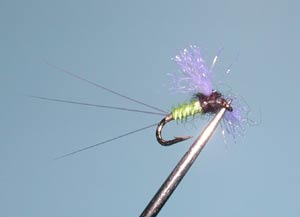
Trico Spinner
Tying Instructions
| Materials
to Order Material, click the link |
|
|---|---|
| Hook | TMC 100 #20-22 |
| Thread | Veevus 8/0 Black |
| Body | Light Olive Turkey Biot |
| Thorax | Black Superfine Dubbing |
| Tail | Medium Dun Microfibbetts |
| Wing | Fl. White or Cream Antron Yarn |
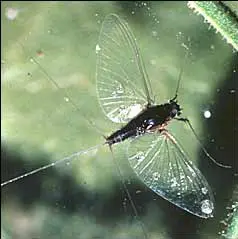
Trico Spinner
The Trico Spinner Fall can be the highlight of any fly fishing excursion within the Sierra. This activity is found usually in areas of slow moving creeks and streams as well as lakes. The males hatch during the night and remain near the stream banks. During the early morning, the females will hatch and become sexually active. A swarm of activity between the males and the females takes place , usually around 8:30 am. Soon afterwards, the males start to die off and will litter the water surface. Sometime around 11:00 am, the females return to the water to lay eggs and die off too. This is the time to switch from a male Trico spinner pattern to a female spinner pattern. The males can be distinguished by a black abdomen, the females tend to have a more pale olive abdomen. This hatch requires a long fine leader and drag-free drifts.
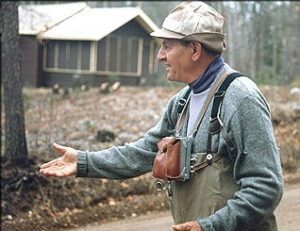
Vince Marinaro
The use of fibers for the spent wings was an innovation of Vince Marinaro, who noted that the use of fibers condenses the water between them and creates streaks of light when viewed from below the surface. Barry Beck improved on the pattern by introducing synthetic material such as Antron, many tiers prefer to use this material in a light grey color rather than white. The pattern I have depicted here is one tied by John Betts, utilizing a light Olive turkey biot for the abdomen. Perfect for the female Trico Spinner. The wings do not have to be tied horizontal as many spinners have a slight tilt upwards.
Variations
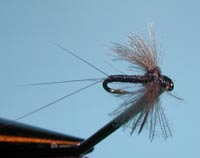
Male Trico Spinner
| Hook | TMC 100 #20-22 |
| Thread | Black 8/0 |
| Body | Black Thread |
| Thorax | Black Thread |
| Tail | Medium Dun Microfibbetts |
| Wing | Med. Dun CDC Hackle |

Female Trico Spinner
| Hook | TMC 100 #20-22 |
| Thread | Uni Thread 8/0 Gray |
| Body | Gray Uni-thread 8/0 |
| Thorax | Black Superfine Dubbing |
| Tail | Medium Dun Microfibbetts |
| Wing | Pearl Krystal Flash |
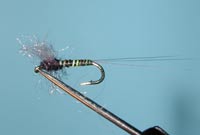
Female Trico Spinner
| Hook | TMC 100 #20-22 |
| Thread | Black Uni-thread 8/0 |
| Body | Baetis Olive dyed Quill |
| Thorax | Black Superfine Dubbing |
| Tail | Medium Dun Microfibbetts |
| Wing | Cream Antron Yarn |
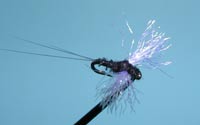
Male Trico Spinner
| Hook | TMC 100 #20-22 |
| Thread | Black Uni-thread 8/0 |
| Body | Black Turkey Biot |
| Thorax | Black Superfine |
| Tail | Medium Dun Microfibbetts |
| Wing | Fl. White Antron Yarn |

